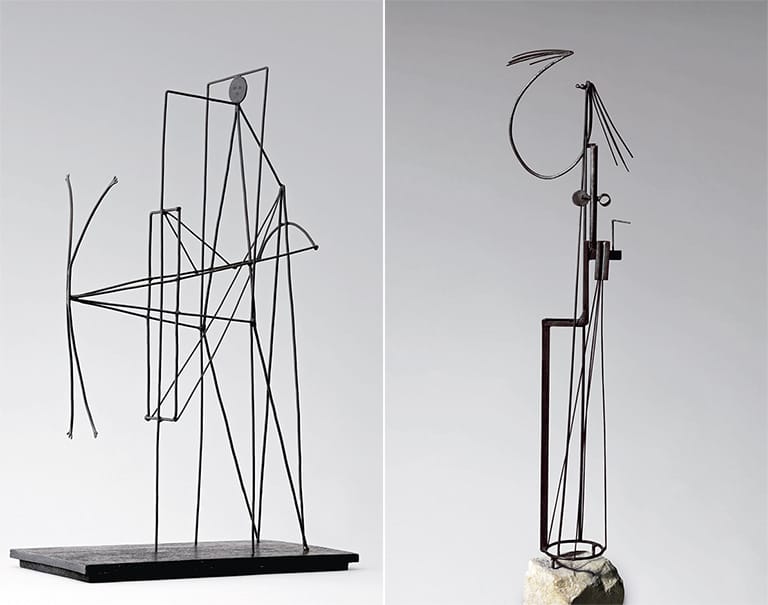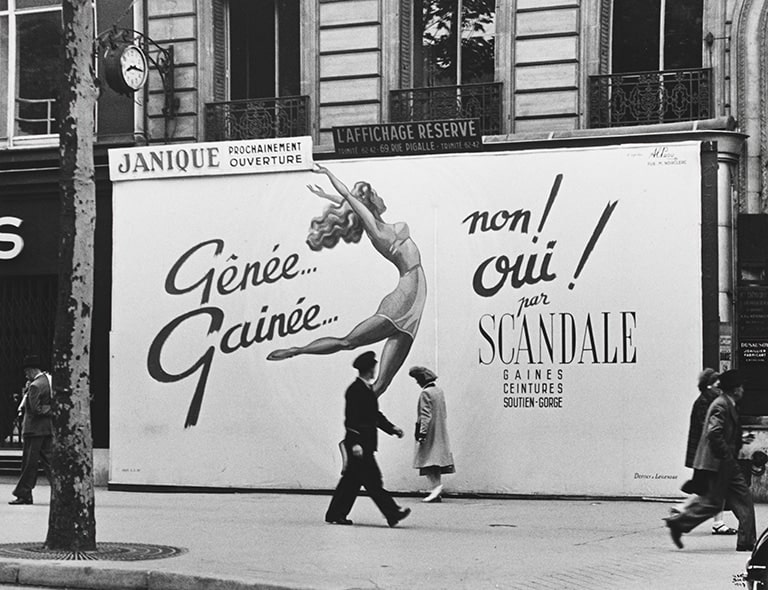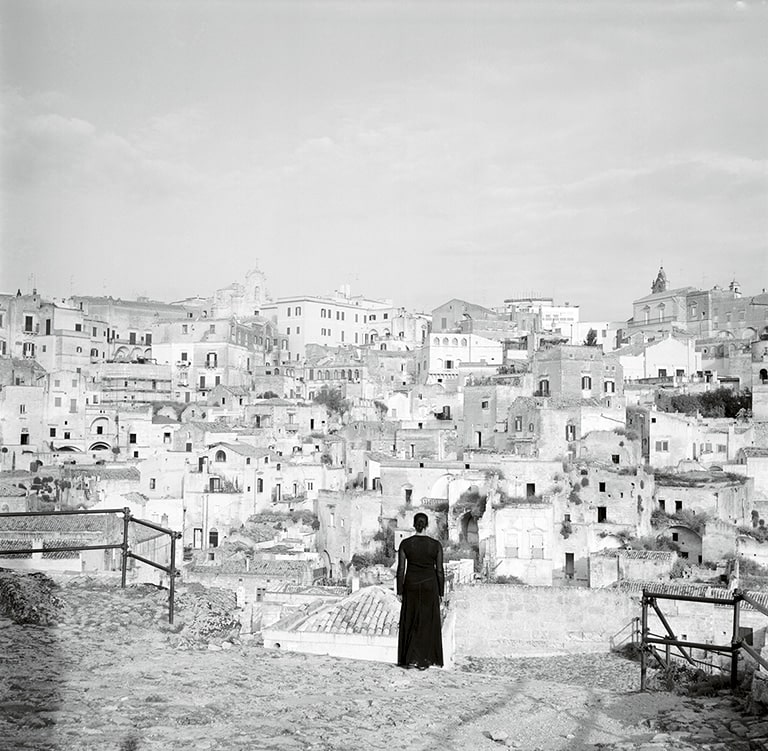Guerre Esthétique [The Aesthetic War]
![Guerre Esthétique [Guerra Estética] Guerre Esthétique [Guerra Estética] © COLECCIONES Fundación MAPFRE](/media/arte-cultura/colecciones/salvador-dali/fm000270.jpg)
Salvador Dalí
Guerre Esthétique [The Aesthetic War], 1943
© Fundació Gala-Salvador Dalí. VEGAP. Madrid, 2021.
Fundación MAPFRE COLLECTIONS
1943, year 1940 – 1950
Entry date: 1998
Technique
Ink and watercolor on paper
Dimensions
Printed area: 72.4 x 57.2 cm (28 1/2 x 22 1/2 in.)
Frame size: 108 x 93 x 4 cm
Paper size: 73 × 58 cm (28 3/4 × 22 13/16 in.)
Inventory
FM000270
Description
In the summer of 1940, in view of the direction that the Second World War was taking, Dalí and Gala decided to return to the United States. A year earlier, the artist had been harshly reproached by André Breton from the pages of Minotaure, leading to his expulsion from the Surrealist group. And this expulsion came to coincide — by necessity, given that Dalinian chance was even more objective than that of the Surrealists— with the painter’s determination to redirect his life. The terms of this redirection can be found in a letter Dalí wrote to Buñuel, later published by Gibson (1997). In his letter, Dalí upheld the frenzied egotism of his behavior, based on the full assumption of the pleasure principle as opposed to the principle of reality; he announced his personal dissolution of his William Tell complex, as in the hostility he felt towards his father; he announced his determination to systematically destroy all his childhood past, represented by his friends in Madrid, and he reaffirmed Gala as his one and only reality. In addition, the letter to Buñuel is strewn with ambiguous allusions in favor of Fascism, Franco and Catholicism. A certain sector of the North American public loved this facet of Dalí, somewhere between systematic scandal and show business. It was to this audience that Dalí directed his ‘Declaration of the Independence of the Imagination and the Rights of Man to his Own Madness’ in 1939, a manifesto that announced his break with all the ties that bound him to the logical systems of the past, and advocating the exclusive use of his personal mythology.
La Guerre Esthétique was one of the artist’s few allusions to his own process of transformation. This is related to the images in works such as Family of Marsupial Centaurs and Knights on Parade, or the studies he made for the set design of Labyrinth (1941). But in Guerre Esthétique there seems to be a clear reference by the artist to the figures of Laocoön, of the metopes representing the battles between the Lapiths and Centaurs of numerous classical Greek temples, of Raphael’s The Fire in the Borgo, and above all the scenes of the Massacre of the Innocents by Nicolas Poussin and Guido Reni. On the other hand, it is still significant that the characters in the drawings most possessed by combative hubris have ovoid heads, this being a clear allusion to one of the ways the artist used to portray himself in his early works such as The Lugubrious Game (1929) and The Metamorphosis of Narcissus (1937), among others. The battle that was being waged was, therefore, established in (or by) the artist himself between the classic traditions of art and the images that emerged from psychoanalytic surrealism. Yet in the drawings, the battle takes place in the presence of a figure, barely outlined, who watches the warlike furor of his surroundings impassively and represents an Ephebe, subtly androgenous, with a ridiculous axillary hairiness. There can be no doubt that in this image Dalí wanted to suggest a retrospective metaphor of himself.
[Eugenio Carmona]
400 obras de Salvador Dalí, 1914-1983, cat. exp. Madrid, Ministerio de Cultura/Generalitat de Catalunya, 1982, 1983.
ABADIE, Daniel, Salvador Dalí: rétrospective 1920-1980, cat. exp. Paris, Centre Georges Pompidou, 1979.
DESCHARNES, Robert (ed.), Oui: the parnoid-critical revolution. Boston, Exact Change, 1998.
DI CAPUA, Marco, y BRU DE SALA, Xavier, Salvador Dalí: su vida, su obra. Barcelona, Caroggio, 2003.
FANÉS, Félix, Salvador Dalí: la construcción de la imagen, 1925-1930. Madrid, Elecat, Fundación Gala Salvador Dalí, 1999.
FANÉS, Félix, Dalí. Cultura de masas, cat. exp. Barcelona, Fundación La Caixa, Fundación Gala-Salvador Dalí y MNCARS, 2004.
FERNÁNDEZ-BRASO, Miguel, Dalí: pinturas, acuarelas y dibujos, cat. exp. Madrid, Galería Juan Gris, 1997.
GAILLEMIN, Jean-Louis, Salvador Dalí: désirs inassouvis: du purisme au surréalisme, 1925-1935. Paris, Nueva York, Le Passage, 2002.
GIBSON, Ian; SANTOS TORROELLA, Rafael; FANÉS, Félix; BONET, Juan Manuel; ADES, Dawn; SÁNCHEZ VIDAL, Agustín, Dalí joven (1918-1930), cat. exp. Madrid, Museo Nacional Centro de Arte Reina Sofía, 1994.
MICHLER, Ralf, y LÖPSINGER, Lutz W. (ed.), Salvador Dalí: catalogue raisonné. Múnich, Prestel, 1994-1995.
RAMÍREZ, Juan Antonio, Dalí: lo crudo y lo podrido. Madrid, Antonio Machado, 2002.
SÁNCHEZ VIDAL, Agustín, Salvador Dalí. Madrid, Fundación MAPFRE, 2007.
SANTOS TORROELLA, Rafael, La miel es más dulce que la sangre: las épocas lorquiana y freudiana de Salvador Dalí. Barcelona, Seix Barral, 1984.
SANTOS TORROELLA, Rafael, Dalí: época de Madrid: catálogo razonado. Madrid, Publicaciones de la Residencia de Estudiantes, Ayuntamiento de Madrid, Área de las Artes, 2004.
SANTOS TORROELLA, Rafael, El primer Dalí, 1918-1929: catálogo razonado. Valencia, Madrid, Institut Valencià d’Art Modern, Publicaciones de la Residencia de Estudiantes, D.L. 2005




